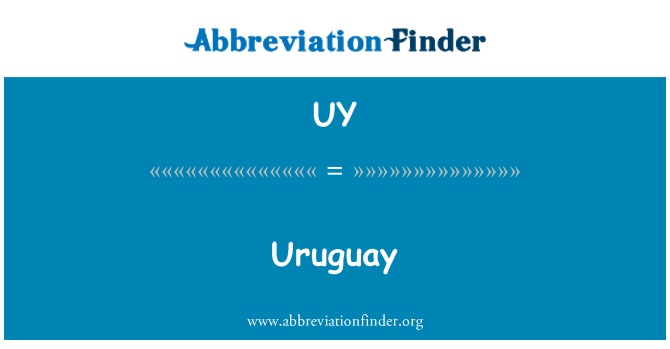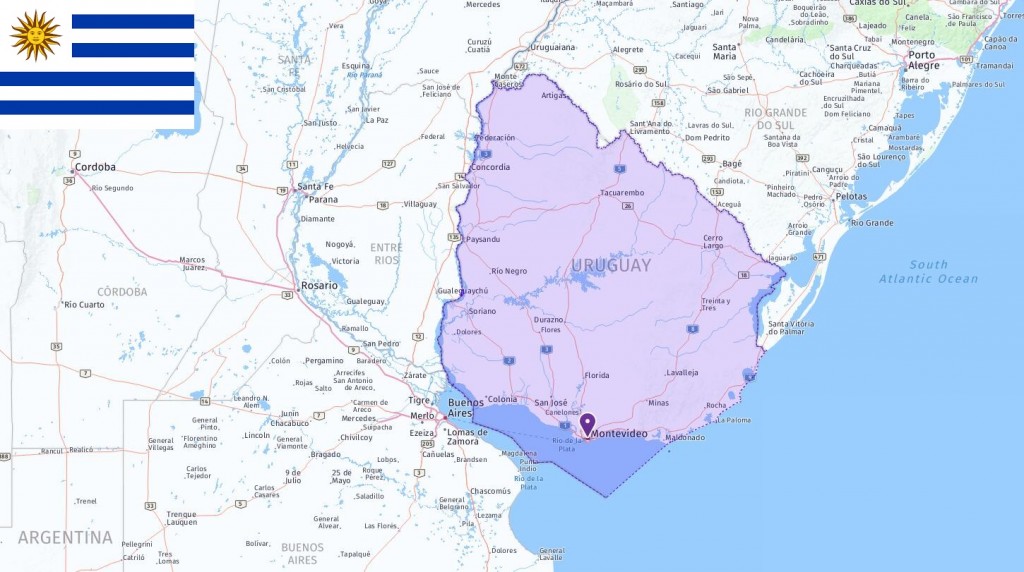UY is the abbreviation for Uruguay, the 89th largest country in the world. Officially Oriental Republic of Uruguay, Uruguay is a country located in South America, bordering Argentina and Brazil. Montevideo is the capital city of Uruguay. Major cities include Montevideo (population: 1,270,726), Salto (population: 99,812), Paysandú (population: 73,238), Las Piedras (population: 69,671), Rivera (population: 64,620), Maldonado (population: 55,467), Tacuarembó (population: 51,843), Melo (population: 51,012), Mercedes (population: 42,348), and Artigas (population: 41,898).
Country Profile
- Capital: Montevideo
- Language: Spanish
- Area: 176,215 km2
- Population: 3,444,006
- Currency: Uruguayan peso (UYU)
- Time zone: UTC−3
- Calling code: 598
- ISO 2-Letter Abbreviation: UY
- UN 3-Letter Abbreviation: URY
- Internet TLD: .uy
- State Government Website: portal.gub.uy
List of Uruguay Acronyms
The most commonly used abbreviations about Uruguay are UY which stands for Uruguay and UYU which means Uruguayan peso (Uruguay currency). In the following table, you can see all acronyms related to Uruguay, including abbreviations for airport, city, school, port, government, and etc.

Geography
Uruguay is one of the smallest countries in South America. The land area forms the transition between the highlands of Brazil and the Argentine plain. At the border with Brazil there are two high rises, which run inland in the southeast direction. To the south, the hills are replaced by plain landscapes. About 85 percent of the land is covered by grass steppes, which are largely used for pasture. Río Negro is Uruguay’s most important river. It divides the land across and forms several narrow lakes. Río Negro flows into the Uruguay River, which forms a natural border with Argentina. Along the rivers are narrow forest belts.
Uruguay is located in the subtropical climate belt and has four seasons. It is warmest from December to February and from June to August it is winter. Then the temperature can drop to zero, but there is no snow in the country. In 2006, Uruguay built a pulp mill on the Uruguay River. This led to major protests from Argentine environmental activists, and the case went to the international court. It came to the conclusion in 2010 that the business could continue because it does not conflict with environmental requirements. Air pollution caused by industry is a major problem, especially in densely populated areas.
History
Because Uruguay did not have gold deposits, it was late colonized compared to other Latin American countries. However, towards the end of the 17th century, Portugal and Spain established colonies in the area. The countries fought for the right to Uruguay until 1776. Then the whole country became a Spanish colony. The Indians were almost exterminated, and a few kingdoms owned all the land. The Napoleonic wars of the early 19th century weakened Spain, and the colony collapsed.
Portugal took power, and in 1817 Uruguay became part of Brazil. Five years later, Brazil gained independence from Portugal, and with the help of the United Kingdom, Uruguay achieved independence in 1828. The liberal Colorado Party and the conservative Blancoparty were formed in the 1830s. Violent conflicts between these parties characterized the rest of the century. In 1903, the Colorado Battle of José Battle y Ordóñez was elected president, and conflicts calmed down. Ordóñez laid the foundation for a modern democracy and a welfare state that was unique in Latin America.
Uruguay was hit by economic problems in the 1950s, which led to new social unrest. In 1973, the military took power. Torture, murder and imprisonment of oppositional 1970s. Because the military junta failed to halt the economic downturn, it relinquished more and more power in the 1980s. In 1985, Sanguinetti became the first civilian president in 12 years, and society became increasingly free.
Society and politics
Uruguay is a republic. The president is both head of state and government and chooses the government itself. The same person cannot be president for two consecutive terms. Uruguay is one of Latin America’s most democratic countries. All constitutional amendments must be approved by referendum. The two right-wing parties Blancos and Colorados have dominated politics since the 19th century. In the 2000s, other political parties also gained greater support.
The level of education in Uruguay is very high compared to other Latin American countries. All education is free, including at the university level, and a large proportion of all young people study. Living standards are relatively high, and the proportion of poor people is low compared to the rest of the continent. In 2012, Uruguay legalized abortion and same-sex marriage, and. In 2013, Uruguay became the first country in the world to legalize marijuana.
Economics and Commerce
Uruguay’s economy is characterized by agriculture and exports of agricultural products. Cattle farming and sheep farming dominate the agricultural sector, and the country has long exported meat, wool and leather. In recent years, soybeans have also become an important export commodity. The dependence on export earnings from a few agricultural products makes the economy vulnerable to fluctuations in the world market. That is why Uruguay is trying to develop other industries, such as tourism and financial services.
The capital Montevideo has long been one of South America’s most important financial centers. The country has a reputation for being a tax haven, but after criticism from outside it has become more transparent about the banking sector. The standard of living in Uruguay is higher than in many other Latin American countries. The percentage of people living in poverty is low, and the country has a well-functioning welfare system.
UN RPGs
In the 2017/2018 school year, the UN Association offers a game in which the student will resolve a conflict in the Security Council. Uruguay is a member of the Security Council and information that follows is related to their role in this game.
Relationship with land in the Security Council
Historically, Uruguay has a close relationship with the United Kingdom. After World War II, the United States also became an important partner, and Uruguay is positively aligned with the West in general.
Tips
Uruguay often contributes troops to UN peacekeeping operations.
As a small country that has previously been the victim of larger countries acting as they please, Uruguay relies on the principle of non- intervention. In other words, it is an important point for Uruguay that each country decides even within its own borders. In addition, they also want to focus on providing relief to the suffering population.
Uruguay is a country that is rarely in the Security Council. That is why it is important for them to show action, for example, by the Council being able to pass a resolution. They will therefore be a driving force to get enough countries to agree on a resolution text. Then it is advisable to talk a lot with the other delegations to find out which issues might be large enough.
Uruguay also sat in the Security Council in 2016, voting for a resolution number 2266 on the conflict in Yemen.
- encourages all groups to abstain from violence and work for a peaceful transition to a new government.
- Expresses concern about humanitarian attacks on civilians
- Expresses concern about al-Qaeda’s strong position in the country.
At a Security Council meeting on July 12, 2017, Uruguay commented on the air strikes in Yemen. They emphasized that many civilians, including many children, are killed by these attacks. Uruguay called it barbaric, demanding that the air strikes stop. They also believe that the Security Council should set up a commission of inquiry to report on human rights violations in Yemen.
View this article in other languages:
Deutsch – Français – 繁體中文


